Pomeranian
Updated December 15, 2025
Pomeranian
Updated December 15, 2025
Pomeranians are playful, peppy pups who need to keep their paws moving and bright mind engaged. Boasting a peppy personality, the delightful Pom is perfect for anyone seeking a lively bestie whose love language is quality time.
Bright, Cheeky, Opinionated
3–7 pounds
6–7 inches
12–16 years
Blue Merle, Blue Sable, Black, Black and Tan, Blue, Blue and Tan, Chocolate, Chocolate and Tan, Cream, Cream Sable, Orange, Orange Sable, Red, Red Sable, Beaver, White, Wolf Sable, Tricolor
Don’t underestimate the little powderpuff that is the Pomeranian. While it could be easy to dismiss this cloud-shaped creature as just a bunch of (literal) fluff, they’re smart, inquisitive, and high-spirited dogs who love to put on a show.
Even if they weren’t all born in August, when it comes to zodiac signs, Pomeranians are Leos at heart: affectionate, outgoing, and just a bit of a showoff—plus they literally have a lion-like mane. For these little scene stealers, the whole world’s a stage—and everyone’s a fan.
Pomeranian Characteristics
Pomeranian Appearance
The Pomeranian is a tiny dog whose fur is often the red-orange of a sunset, with enough fluff to give off lion vibes. They have dark, almond-shaped eyes and alert ears set high on their fox-like heads. Their expressive, feathery tail curves over the back of their double coat.

- Ears
Poms’ ears are small, alert, and sit high on the head.
- Eyes
Their medium-sized eyes are almond-shaped and most commonly dark brown, though other colors are possible.
- Nose
Poms have a black nose, but it can also be the same color as their fur in blue-gray, chocolate, or beaver (a brown with shades of cream, beige, or orange).
- Coat Length
Pomeranians have a double coat, with short, thick fur below and an abundant coarse outer coat.
- Coat Color
Pomeranian colors number two dozen, including their different patterns and markings. Orange- and red-toned coats are the most common.
- Tail
A Pomeranian’s tail is thickly plumed, set high on the back, and lies flat.
Pomeranian Temperament
You might have a clever, happy-go-lucky friend who’s always at every party and is equal parts approachable and enviable. That’s a Pomeranian. These adorable pups live for social interactions and to make their pet parents laugh out loud.
If you have kids, chances are your Pomeranian will love them—but as with any dog, teach your kids to handle small dogs with care. (Who could blame a child for thinking all that fur was their favorite stuffy?) Poms will probably get along with cats, too, and anyone else they happen to meet, even if they can be a little sassy at times.
Not only are they cute dogs, but they also win in the smarts department. Your Pomeranian will likely be able to pick up new tricks very quickly, and they’ll probably ace obedience school. (You might also be able to use that time to teach them how exciting it is to use their indoor voice—and keep the barking to emergencies.)
And if you’re looking for an Instagram buddy to show off your adventures together, most Poms are ready for the limelight. They’re sometimes described as a little overconfident, but who wouldn’t be proud of such a bright mind and bouncy personality?
How to Care for a Pomeranian
Though they’re perhaps most well known for their fluffy fur coat, there’s more to Pomeranians than cuteness. Poms are super smart and excel at learning new skills. They’re also active, but it’s easy to get their exercise in—even in your own home.
Grooming
Training
Diet
Exercise
Environment
Pomeranian Health
The Pomeranian lifespan is 12–16 years. They’re generally healthy pups, but they have some health issues pet parents should be aware of.
- Eye issues: Pomeranians may develop cataracts (cloudiness in the eye’s lens) and entropion (a condition that causes the eyelids to roll inward). These may be genetic and can be diagnosed and treated by your vet or a veterinary ophthalmologist.
- Hair loss: This breed’s fluffy locks could be affected by hair loss, though it’s mostly seen in male Poms. Known as Alopecia X, there is no genetic screening test, but it is hereditary, and it’s important to rule out other conditions as well.
- Hip issues: Pomeranians are prone to Legg-Calve-Perthes disease and hip dysplasia; both cause mobility issues. Depending on the severity, surgery may be needed.
- Hypoglycemia: Low blood sugar is common in very small and very active Poms. They might be weak, sleepy, or disoriented, and they might tremble, collapse, or have a seizure. Feed your dog on a regular schedule to prevent hypoglycemia; most pups eventually outgrow it.
- Hypothyroidism: Very common in Poms, signs of hypothyroidism include lethargy, hair thinning, a dry coat, skin and ear infections, and weight gain. A vet can diagnose it with a blood test, and it’s treated with oral meds.
- Luxating patella: Luxating patella, or when the kneecap slides out of place, causes a limp that comes and goes. This condition can also lead to progressive arthritis. In severe cases, surgery may be needed.
- Tracheal collapse: Tracheal collapse happens when the windpipe flattens. It makes it hard for Pomeranians to get air into the lungs, and as a result many affected dogs may make a dry, goose-like honking sound. Pups with this condition should have their leash attached to a harness, not a collar (which can push on the trachea), and treatment may include weight management, medications, or surgery.
Pomeranian History
Named for a historical region called Pomerania along the Baltic Sea, the Pomeranian’s modern origins are rooted in Poland and Germany. However, it’s said that those dogs were descended from large, wolflike pups who once lived in Iceland.
Poms are actually related to the breed of larger sled-pulling Spitz dogs, characterized by their pointy ears, thick coats, and a big tail that curves along the back. While Poms can trace their lineage to sled dogs in Iceland, the breed has officially retired from this cold-weather position—and is much smaller than their ancestors were.
The British are big fans of Poms, thanks to the prominence the breed gained after Queen Victoria of England spied this pup while on a trip to Italy. She returned home with Poms in her bags and proceeded to breed and show the dogs for many years. In fact, it’s Queen Victoria who was largely responsible for the tiny size we associate with Pomeranians today. Once a midsize dog of 30 pounds, Pomeranians now sit side by side with Chihuahuas and Maltese as one of the smallest dog breeds.
Pomeranians came to the United States in 1892 and are among the oldest of recognized American Kennel Club breeds, gaining the AKC distinction in 1888. In 1911, the American Pomeranian Club hosted its first specialty show—just for Poms!
A Pomeranian puppy can cost between $500 to $1,500. If you choose this route, pick a responsible breeder.
You can also consider Pomeranian adoption, as there are many searching for their forever homes. You can adopt a Pomeranian by reaching out to a Pomeranian rescue like Peace, Love & Poms, asking around at your local animal shelter or rescue organization, or searching Chewy’s database of adoptable dogs in your area.








